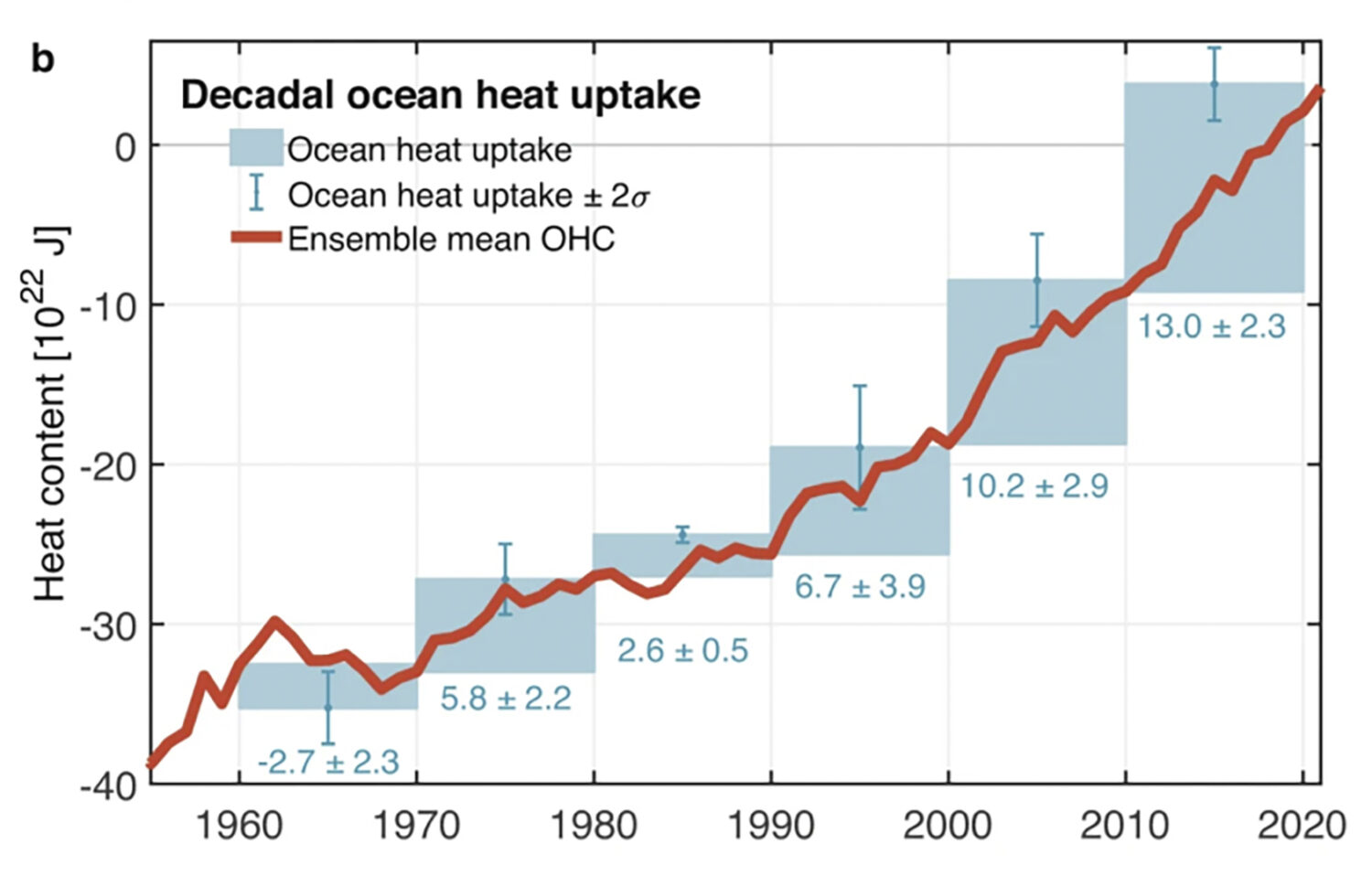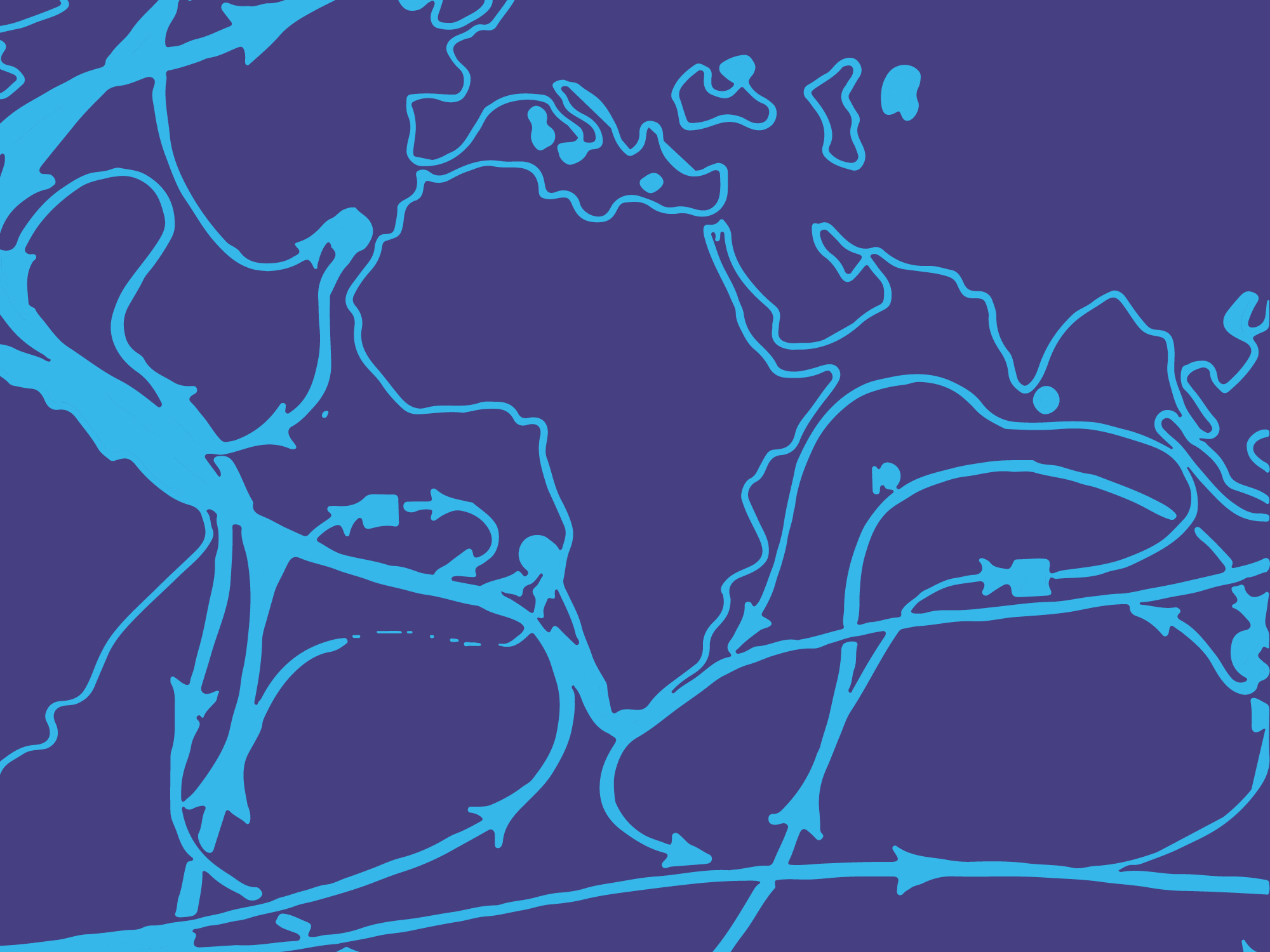When we look at the Earth, the oceans, as the largest region in terms of surface area, are still little studied, and their nature is poorly understood. Climate researchers are concerned and questioning the extensive reports of temperature changes, ocean acidification and changes in ocean currents. Civilization’s conversion of fossil hydrocarbon compounds into carbon dioxide is having an increasingly disastrous effect on this habitat with its many living creatures.
Life Began in the Sea
The oceans were the environment wherein single-celled organisms first appeared on Earth, in the Archean Eon. Later, in the transition to the Palaeozoic, simple multicellular organisms joined them, and, with the beginning of the Palaeozoic, the differentiation of animals into eighteen animal phyla, up to simple fish-like vertebrate, also took place in the shallow waters of the oceans.1 The watery and rhythmically moving ocean provided the ideal conditions for new life forms. The worldwide distribution of the oceans made it possible that, despite changing climatic conditions and varying positions of the continental land masses, there were always shallow seas, where conditions for the development of terrestrial life were favorable. It was only later, towards the end of the Palaeozoic era, that higher vertebrates and land plants developed in the coastal regions of the continents.
The Equilibrium of Ocean Currents
The oceans are a picture of water in motion. Water is subject to gravity and is always moving. As a rule, there is a pure equilibrium of flow integrated into rhythms. In the movement of huge masses of water, there is never a blockage or a standstill, nor are there any gaps. The movement of each drop of water is connected to the movement of all other drops of water. If we want to understand this movement, we have to be in all places around the globe at the same time with our attention and our mental movement. Thinking and mobility must be developed together and all at once. The causality of if-then is not enough for grasping the ocean currents with our thinking. A mechanistic idea of a drive pump for the movement of the ocean masses does not lead to satisfactory results.

Let’s take a look at the Gulf Stream. It is known to seafarers as a surface current that flows from the North African coast together with the trade winds towards the Caribbean islands, continues along the eastern edge of North America, crosses the North Atlantic, and returns southwards towards the coast of North Africa via the French and Spanish coastlines. Columbus sailed his ships by way of this current on his voyage of discovery. But this picture is incomplete. These bodies of water also move vertically, sinking in the polar regions and rising mainly at the western edges of the continents.
In Fig. 1, showing the global Gulf Stream system, the thin arrows represent the comparatively faster surface currents. The black dots mark the areas where the surface water sinks very slowly and turns leisurely towards the equator at the bottom of the oceans (shown with thick arrows). The path of this current is limited by the continents and the mid-ocean ridge (green, see Fig. 2). The deep current develops in the ascent over the mid-ocean ridge to medium water depths of around 2000 meters. Further ascent in an easterly direction (indicated by the thick dashed line) leads to upwelling areas (marked with x’s), above which the opposing surface currents flow.

If we now follow the bodies of water near the surface of the classic Gulf Stream [red arrows] proceeding from Florida in the simplified map (Fig. 3), we reach the sinking zones [black hatching] near Svalbard and Greenland. The subsequent seafloor currents cross under the surface current, rise slowly as deep currents [blue] to the upwelling area [red “x”] near the Canary Islands off northwest Africa, turn clockwise, and are then reintegrated into the classic Gulf Stream [red arrows]. Tracing this path, we discover the form of a three-dimensional lemniscate in the ocean movements of the North Atlantic. As Fig. 3 shows, another part of the seafloor waters [black arrows] moves southwards, from the Greenland coastal currents further into the South Atlantic, where they integrate into the Transantarctic current, sink again in the Weddell Sea [northwest Antarctica], and form another three-dimensional lemniscate as they rise again in the South Atlantic [blue arrows, red x’s, red arrows]. However, a lemniscatic reversal can also occur in the Indian Ocean on the west coast of Australia, in the equatorial Pacific, or even in the eastern South Pacific. This always occurs after the bodies of water have been temporarily absorbed by the large Transantarctic circulation current.4
We observe that the ocean water movement has the following characteristics: the movement impulses proceed from five three-dimensional lemniscatic movements of currents in the three great oceans. Everything is connected to everything else in the flow of movement, so that a rhythmic-dynamic, flowing equilibrium arises. This astounding event—initially inaccessible to the observing human being—which occurs in such an important part of our Earth, demands an especially agile capacity of discernment.

Exchange between Atmosphere and Ocean
There is a constant exchange of carbon dioxide at the interface between the atmosphere and the ocean.6 Depending on the region, temperature, and conditions of life, the water either absorbs carbon dioxide or releases it into the atmosphere. In the cool seas around the Antarctic, the North Atlantic, and the North Pacific, the uptake of carbon dioxide, and thus the amount of carbon dioxide present, is especially high and reaches depths of over 1000 meters. The warmer equatorial waters contain significantly less carbon dioxide. Presently, the oceans have taken up a third of the carbon dioxide released into the atmosphere by human beings. Thereby, the oceans have been able to temporarily mitigate the continental climate problem.
The carbon dioxide absorbed in the water changes in three ways. Firstly, it is partially chemically converted into other compounds. Secondly, the photosynthesizing unicellular organisms, phytoplankton and algae absorb carbon dioxide and form biomass that is then available to feed bacteria and animals. Zooplankton use carbon dioxide to form calcium carbonate shells. When these animals die, their shells sink to the seafloor of the oceans and remain removed from the atmosphere as mineralized carbon for millions of years. Carbon also “disappears” when dead biomass from marine life cannot be completely converted back into carbon dioxide by bacteria. Under suitable geological conditions, these remnants of biomass are converted into oil, gas, or coal. Through these processes, life in the oceans has corrected excessive warming or cooling of the atmosphere in the course of the Earth’s history.
What is dramatic now, however, is that with the beginning of the industrial age, we human beings have disrupted the temporal rhythmicity of the above-mentioned processes. With the industrial exploitation of coal, oil, and gas, we have accelerated the resurgence of the carbon compounds bound in the Earth’s depths by a factor of 10,000 in comparison with the naturally occurring processes.
The Connection between Ocean Warming and the Course of Ocean Currents
What significance do the ocean currents have for the life distressed by the increasingly evident disruption of the climate? And how does global warming affect ocean currents? The warming of the atmosphere and land masses caused by human civilization has an effect right down to the depths of the oceans. The oceans have so far absorbed 90 percent of the heat generated by human activities and thus removed it from the atmosphere. If this had not happened, life on the continents would have been almost unbearable for some time. The oceans balance out opposites—as far as this is possible. Research findings from recent years now show an increasingly accelerated warming of ocean waters that remarkably, extends down to a depth of more than 2000 meters.7 Between 1960 and 2002, ocean waters warmed by an average of 0.5 °C and between 2002 and 2022 by almost 1 °C.
This has consequences for the sinking of surface waters in the sinking regions of the North Atlantic and near the Antarctic. The movement of the global Gulf Stream system is in danger of falling out of balance. A new and controversial study predicts that the Gulf Stream could collapse before the end of this century.8 Even critics of this oft-cited prognosis do agree, however, that the Gulf Stream system in the North Atlantic has slowed down and lost stability.9 This process began around 1970 and has intensified significantly since 2015. It is related to the abnormal warming of the North Atlantic and the increased meltwater input due to the increasing melting of the Greenland and Arctic ice masses.10
It is not only the sinking regions in the North Atlantic that are weakening. The situation in the Antarctic Ocean is probably even more dramatic.1112 The world’s greatest heat uptake extends to depths of 2000 meters in connection with the deep-reaching Transantarctic current. From out of these depths, the warm water rises southwards into the sinking regions. There, the water has already become lighter due to the large influx of meltwater from the Antarctic ice. All this, together with the decline in the cycle of life and death of protozoa and krill, slows down the sinking and, thereby, the strength of the seafloor current. With the weakening of the sinking movements in both the northern and southern hemispheres, the global ocean circulation is under great stress.

Oceanic Heatwaves
The year 2023 and the first months of 2024 have been characterized by a previously undetected heat wave in various areas of the ocean. Experts agree that this abnormal warming of the water would not have occurred without the anthropogenic warming of the atmosphere. On the one hand, there is a naturally occurring process, the El Niño–Southern Oscillation. During the El Niño phase [the process has two other phases], the westward trade winds in the eastern Pacific weaken, and, as a result, the surface water that has warmed in the western Pacific is transported to the American coast. During El Niño phases, it is slightly warmer worldwide. However, this naturally occurring factor is not sufficient to explain the oceanic heat waves. It is argued that weaker easterly winds from the Sahara have brought less desert dust to the Atlantic. Since desert dust promotes cloud formation, a cooling effect will arise with the presence of dust. The reduction in the sulphur content of marine diesel fuel can also contribute to the warming of the water. This is because lowering the sulfur content in the atmosphere means fewer clouds form on busy shipping routes. The third reason cited is the slowing of sinking movements in the North and South Atlantic.
The so-called marine heat waves overlap with the distressing warming of the oceans. Marine heatwaves occur when the water temperature is higher than 90 percent of the 30-year reference period for more than five days. The occurrence of marine heatwaves doubled between 1986 and 2016. Such heatwaves, which often last several months, reach depths of 2000 meters. The animals living there are accustomed to constant cool temperatures and are now in great distress.14 Studies show that more and more cold-water corals are dying off. In addition, the dissolved oxygen content, which is essential for animal life, decreases in warmer water.

Ocean Acidification and Changes in Plankton
Another serious trend is the increasing acidification of ocean surface waters.16 Due to the oceanic uptake of up to a third of anthropogenic carbon dioxide from the atmosphere, the atmospheric greenhouse concentration has become somewhat less pronounced. However, as a result of the increase in dissolved carbon dioxide and the warming of the oceans, the slightly alkaline pH value has become 30 percent more acidic in the last 100 years. This has consequences for zooplankton, which form calcareous shells. Calcification is becoming increasingly difficult. This not only has negative consequences for marine ecosystems but because less calcareous debris reaches the sea floor when the calcareous shells die off, less carbon is mineralized and thus removed from the rapid carbon cycle. A similar process of acidification also took place in earlier geological times, 54 million years ago. The worrying thing, however, is that today’s process is about ten times faster.
Advanced satellite remote sensing technology has made it possible to record the global change in plant plankton populations more precisely.17 An increase in chlorophyll content was found in the ocean regions between 40 degrees north latitude and 40 degrees south latitude. These ocean regions are comparatively less affected by warming. Smaller plankton species, which convert less carbon dioxide than larger ones, are increasingly found there. In principle, plant plankton loves cold waters and is therefore mainly present around the Antarctic and in the northern parts of the Pacific and Atlantic. It is precisely these areas that are most affected by global ocean warming. This explains why the plankton population has not increased there.
Basically, an increasing change in the survival possibilities for marine life can be observed, but also a strong change of location. Plant plankton can migrate to cooler regions more quickly than animal plankton. The interaction between the plant and animal plankton has been thrown out of rhythm. The plant plankton can cope better with the higher carbon dioxide concentration for a time. This further disturbance of balance in the sensitive life processes in the world’s oceans is taking place beyond the scope of human observation. The oceans are in danger of losing their capacity for balancing opposites and providing favorable living conditions for the Earth as a whole. Comparative studies between contemporary and geologically older biotope changes show that, in recent decades, the changes in living conditions have occurred many times faster than in the past, when human influence was not yet present. This shows once again that we humans have broken the naturally occurring rhythms.
Time for a Turn
We human beings are faced with the task of turning our attention to the miracle of the ocean and its life processes. If we do this, we can wake up and begin to take responsibility for the care of the whole Earth. Recognizing the Being of life is a prerequisite for this. It is important to realize that we should not only determine and assess measurable quantities, but also focus our interest on the dynamics of changes in speed and motion. Life processes have an inherent temporal rhythmicity. And today, human beings are increasingly breaking this rhythm through the way they convert energy and their unchecked exploitation of raw materials.
Translation Joshua Kelberman
Title Image Illustration based on a drawing by Hans-Ulrich Schmutz
Footnotes
- H. U. Schmutz, Earth Science for Waldorf Schools (Ghent, NY: AWSNA Publications, 2011), ch. 3 and 9, especially figures 3.1–3.4, pp. 49–50.
- Ibid., 49-50.
- Ibid., 49-50.
- See drawing in H. U. Schmutz, “What Can We Learn From What is Happening in Antarctica?,” the Goetheanum Weekly (Dec. 7, 2023).
- H. U. Schmutz, Earth Science for Waldorf Schools (Ghent, NY: AWSNA Publications, 2011), ch. 3 and 9, especially figures 3.1–3.4, pp. 49–50.
- World Ocean Review 7 (2021), ch. 2, “Oceans under Climate Change”; see fig. 2.7.
- Z. Li, M. H. England, & S. Groeskamp, “Recent acceleration in global ocean heat accumulation by mode and intermediate waters,” Nature Communications 14, art. no. 6888 (2023); see fig. 1b.
- P. Ditlevsen, S. Ditlevsen, “Warning of a forthcoming collapse of the Atlantic meridional overturning circulation,” Nature Communications 14, art. no. 4254 (2023).
- Science Media Center, “Klima und Umwelt: Kritik an Studie zum baldigen Kollaps des Golfstroms” [Climate and environment: criticism of the study concerning the imminent collapse of the Gulf Stream], (July 25, 2023).
- R. M. van Westen, M. Kliphuis, H. A. Dijkstra, “Physics-based early warning signal shows that AMOC is on tipping course,” Science Advances 10, no. 6 (Feb 9 2024).
- Q. Li, M. H. England, A. M. Hogg, S. R. Rintoul, A. K. Morrison, “Abyssal ocean overturning slowdown and warming driven by Antarctic meltwater,” Nature, no. 615 (Mar. 2023): 841–847.
- See drawing in H. U. Schmutz, “What Can We Learn From What is Happening in Antarctica?,” the Goetheanum Weekly (Dec. 7, 2023).
- Z. Li, M. H. England, & S. Groeskamp, “Recent acceleration in global ocean heat accumulation by mode and intermediate waters,” Nature Communications 14, art. no. 6888 (2023); see fig. 1b.
- E. Fragkopoulou, A. Sen Gupta, M. J. Costello, et al, “Marine biodiversity exposed to prolonged and intense subsurface heatwaves,” Nature Climate Change, no. 13 (2023): 1114–1121.
- World Ocean Review 7 (2021), ch. 2, “Oceans under Climate Change,” see fig. 2.7.
- “Facts on Ocean Acidification: Knowledge at a Glance,” Alfred Wegener Institute, Helmholtz Centre for Polar and Marine Research, accessed May 20, 2024.
- B. B. Cael, K. Bisson, E. Boss, S. Dutkiewicz, S. Henson, “Global climate-change trends detected in indicators of ocean ecology,” Nature, no. 619 (July 2023) :551–554.





